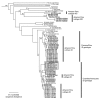Endemic Venezuelan equine encephalitis in northern Peru
- PMID: 15200823
- PMCID: PMC3323213
- DOI: 10.3201/eid1005.030634
Endemic Venezuelan equine encephalitis in northern Peru
Abstract
Since Venezuelan equine encephalitis virus (VEEV) was isolated in Peru in 1942, >70 isolates have been obtained from mosquitoes, humans, and sylvatic mammals primarily in the Amazon region. To investigate genetic relationships among the Peru VEEV isolates and between the Peru isolates and other VEEV strains, a fragment of the PE2 gene was amplified and analyzed by single-stranded conformation polymorphism. Representatives of seven genotypes underwent sequencing and phylogenetic analysis. The results identified four VEE complex lineages that cocirculate in the Amazon region: subtypes ID (Panama and Colombia/Venezuela genotypes), IIIC, and a new, proposed subtype IIID, which was isolated from a febrile human, mosquitoes, and spiny rats. Both ID lineages and the IIID subtype are associated with febrile human illness. Most of the subtype ID isolates belonged to the Panama genotype, but the Colombia/Venezuela genotype, which is phylogenetically related to epizootic strains, also continues to circulate in the Amazon basin.
Figures




Similar articles
-
Identification and genetic analysis of Panama-genotype Venezuelan equine encephalitis virus subtype ID in Peru.Am J Trop Med Hyg. 1998 Jan;58(1):41-6. doi: 10.4269/ajtmh.1998.58.41. Am J Trop Med Hyg. 1998. PMID: 9452290
-
Venezuelan equine encephalitis and 2 human deaths, Peru.Emerg Infect Dis. 2010 Mar;16(3):553-6. doi: 10.3201/eid1603.090970. Emerg Infect Dis. 2010. PMID: 20202445 Free PMC article.
-
Repeated emergence of epidemic/epizootic Venezuelan equine encephalitis from a single genotype of enzootic subtype ID virus.J Virol. 1997 Sep;71(9):6697-705. doi: 10.1128/JVI.71.9.6697-6705.1997. J Virol. 1997. PMID: 9261393 Free PMC article.
-
Venezuelan equine encephalitis virus: the problem is not over for tropical America.Ann Clin Microbiol Antimicrob. 2020 May 19;19(1):19. doi: 10.1186/s12941-020-00360-4. Ann Clin Microbiol Antimicrob. 2020. PMID: 32429942 Free PMC article. Review.
-
Genetic determinants of Venezuelan equine encephalitis emergence.Arch Virol Suppl. 2004;(18):43-64. doi: 10.1007/978-3-7091-0572-6_5. Arch Virol Suppl. 2004. PMID: 15119762 Review.
Cited by
-
Identification of Blood Meals from Potential Arbovirus Mosquito Vectors in the Peruvian Amazon Basin.Am J Trop Med Hyg. 2016 Nov 2;95(5):1026-1030. doi: 10.4269/ajtmh.16-0167. Epub 2016 Sep 12. Am J Trop Med Hyg. 2016. PMID: 27621304 Free PMC article.
-
Venezuelan equine encephalitis virus disrupts STAT1 signaling by distinct mechanisms independent of host shutoff.J Virol. 2009 Oct;83(20):10571-81. doi: 10.1128/JVI.01041-09. Epub 2009 Aug 5. J Virol. 2009. PMID: 19656875 Free PMC article.
-
Venezuelan Equine Encephalitis, Peruvian Amazon, 2020.Emerg Infect Dis. 2025 May;31(5):995-999. doi: 10.3201/eid3105.241694. Emerg Infect Dis. 2025. PMID: 40305379 Free PMC article.
-
Emergence of zoonotic arboviruses by animal trade and migration.Parasit Vectors. 2010 Apr 8;3(1):35. doi: 10.1186/1756-3305-3-35. Parasit Vectors. 2010. PMID: 20377873 Free PMC article.
-
Arboviral etiologies of acute febrile illnesses in Western South America, 2000-2007.PLoS Negl Trop Dis. 2010 Aug 10;4(8):e787. doi: 10.1371/journal.pntd.0000787. PLoS Negl Trop Dis. 2010. PMID: 20706628 Free PMC article.
References
-
- Oberste MS, Fraire M, Navarro R, Zepeda C, Zarate ML, Ludwig GV, et al. Association of Venezuelan equine encephalitis virus subtype IE with two equine epizootics in Mexico. Am J Trop Med Hyg. 1998;59:100–7. - PubMed
-
- Lord RD. History and geographic distribution of Venezuelan equine encephalitis. Bull Pan Am Health Organ. 1974;8:100–10. - PubMed
-
- Watts DM, Callahan J, Rossi C, Oberste MS, Roehrig JT, Wooster MT, et al. Venezuelan equine encephalitis febrile cases among humans in the Peruvian Amazon River region. Am J Trop Med Hyg. 1998;58:35–40. - PubMed
Publication types
MeSH terms
Substances
Grants and funding
LinkOut - more resources
Full Text Sources
Other Literature Sources
